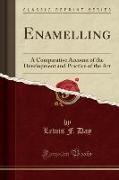Read more
Excerpt from Enamelling: A Comparative Account of the Development and Practice of the Art
What further it is possible to do, what new forms of beauty the near future may bring to birth, remains for each Of us in his generation to show. But no man ever did a thing the worse for knowing how others did it before him. A new departure is best made from the point of View which gives a glance round at the ground already covered. The well-marked paths behind point to the less certain path before. A portion at least Of the experience of others before him is the natural inheritance of every workman, and he is none the poorer when he comes into it. Some knowledge Of what is outside his own experience goes to the expression Of an artist's very self.
We live in days when comparative study is made easier than ever it used to be. Time, after separating out for us the good work Of the past, has drifted it into museums. There we can not only see it as we could scarcely do in the church treasuries where much Of it was long piously preserved from View, but have the opportunity of comparing the best with the best, each piece with others of its kind. A serious student has only to apply to the museum authorities, and they will allow him, Of their courtesy, to examine whatever he is interested in as closely as need be.
The very scope, however, Of the great museums is a source Of confusion and perplexity to the student. They contain so much - some Of historical, some of artistic, some Of purely technical interest! How is a beginner to know what to look at, and what to look for in it?
About the Publisher
Forgotten Books publishes hundreds of thousands of rare and classic books. Find more at www.forgottenbooks.com
This book is a reproduction of an important historical work. Forgotten Books uses state-of-the-art technology to digitally reconstruct the work, preserving the original format whilst repairing imperfections present in the aged copy. In rare cases, an imperfection in the original, such as a blemish or missing page, may be replicated in our edition. We do, however, repair the vast majority of imperfections successfully; any imperfections that remain are intentionally left to preserve the state of such historical works.

